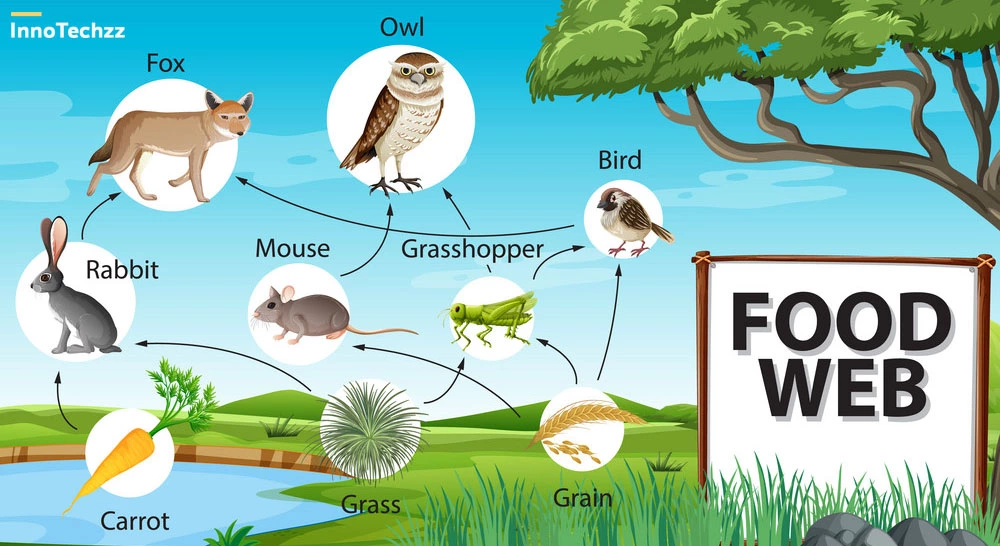Food Web | Forest food web | Desert food web -Innotechzz

A food web is a pictorial representation of what-eats-what in an ecosystems, as well as the natural connectivity of food chains. The consumer-resource system is another term for the food web. Ecologists classify all living things into one of two trophic levels: autotrophs or heterotrophs. Autotrophs synthesise organic matter from inorganic components like as minerals and gases like carbon dioxide to sustain their bodies, grow, develop, and reproduce.
These chemical processes need energy, which is obtained mostly from the Sun and principally through photosynthesis, with a modest contribution from bioelectrogenesis in wetlands and mineral electron donors in hydrothermal vents and hot springs. These trophic levels are not binary, but rather constitute a gradient that covers full autotrophs , mixotrophs (autotrophic creatures that receive organic matter from sources other than the atmosphere), and complete heterotrophs (which must feed to obtain organic matter).
The feeding paths, such as where heterotrophs receive organic matter by feeding on autotrophs and other heterotrophs, are depicted by the links in a food web. The food web is a simplified representation of the numerous feeding strategies that connect an ecosystem into a single exchange system. Herbivory, carnivory, scavenging, and parasitism are some of the numerous types of feeding relationships that exist. Heterotrophs get energy from some of the organic substances they ingest, such as sugars. From cyanobacteria to enormous redwoods, and from viruses and bdellovibrio to blue whales, autotrophs and heterotrophs exist in different sizes, from microscopic to several tonnes.
Forest food web
In the forest, the food web is made up of numerous tropic (food) levels populated by species that feed at that level and also provide food for organisms at lower levels. The food web is tightly linked, and any of the trophic levels that are considerably damaged or absent will cause the food web to collapse.
1. Producers
2. Consumers
3. Decomposers
The forest food web's producer level is made up of plants and trees. They use sunlight to convert carbon dioxide into sugars, which produces oxygen as a byproduct of the process. Plants produce biomass and stored energy in the food chain, to put it another way. The producers are eaten by the consuming creatures in the level above, such as insects, deer, and rodents. At this level, symbiosis occurs in the forest, such as bees gathering nectar while pollinating plants.
Consumers, unlike plants, are unable to produce their own food, thus they must consume other species. In the forest, there are primary, secondary, and tertiary consumers. Large herbivores like deer, as well as insects, rabbits, and rodents, are the main consumers. Plants, seeds, berries, and grasses are the main foods of these species. Carnivorous creatures that only eat herbivores are secondary consumers. Smaller predators like foxes are among these consumers, but ants, fish, spiders, snakes, and rats are also secondary consumers.
Tertiary consumers, such as carnivores and omnivores that devour the creatures on the secondary consumer level, are further up in the forest food chain. Owls are one example of these creatures. The apex predators live above the tertiary consumers. These creatures consume both carnivores and omnivores, yet they have no natural predators. Bears, hawks, and huge snakes like the anaconda are examples of the forest food web.
In the forest, decomposers such as earthworms, bacteria, fungus, and insects take care of the dead plants and animals. They break them down into smaller and smaller pieces, creating new soil in the process. The food chain continues as the nutrients are consumed by plants at the producer level.
Desert food web
A desert food chain is a graphic that represents the flow of energy across a desert environment. Food chains illustrate the linear transmission of energy across an ecosystem in the form of food consumption. In a food chain, there are two sorts of organisms: producers and consumers. Producers, which are mainly plants or bacteria, are creatures that produce their own nourishment. Consumers, such as animals and fungus, are creatures that consume to acquire energy. Consumers can be classified according to their position in the food chain. Producers eat primary consumers. Primary consumers are eaten by secondary consumers. Primary and secondary consumers are eaten by tertiary consumers.
1. Producers
2. Herbivores
3. Omnivores
4. Carnivores
Producers, or creatures that manufacture their own food, are the foundation of desert food chains. Grass, cactus, and tiny trees are the most common producers in the desert. These plants have evolved to be able to conserve water in the desert's arid environment.
In a desert food chain, herbivores are critters that consume the producers, or plants. Insects and tiny mammals such as ants and squirrels are examples of herbivores. Primary consumers are herbivores.
Omnivores are animals and plants that consume each other. Some tiny mammals in the desert environment consume both vegetation and animals. The grasshopper mouse consumes both grasses and grasshoppers, such as brittlebrush. Omnivores, on the other hand, are frequently secondary consumers.
Carnivores are predatory creatures that consume exclusively other predatory animals. These creatures are usually found towards the top of the food chain. In the desert, carnivores include snakes, scorpions, and hawks. Primary and secondary consumers are both carnivores.
Posted By InnoTechzz